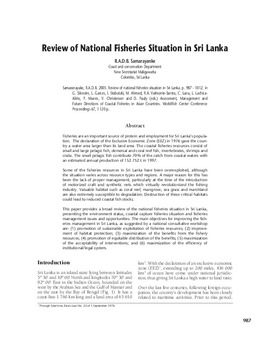Review of national fisheries situation in Sri Lanka

Citation
Samarayanke, R.A.D.B. (2003). Review of national fisheries situation in Sri Lanka. p. 987-1012. Assessment, management and future directions for coastal fisheries in Asian countries. WorldFish Center conference proceedings; 67
Fisheries are an important source of protein and employment for Sri Lanka’s population. The declaration of the Exclusive Economic Zone (EEZ) in 1976 gave the country a water area larger than its land area. The coastal fisheries resources consist of small and large pelagic fish, demersal and coral reef fish, invertebrates, shrimps and crabs. The small pelagic fish contribute 70% of the catch from coastal waters with an estimated annual production of 152 752 t in 1997. Some of the fisheries resources in Sri Lanka have been overexploited, although the situation varies across resource types and regions. A major reason for this has been the lack of proper management, particularly at the time of the introduction of motorized craft and synthetic nets which virtually revolutionized the fishing industry. Valuable habitat such as coral reef, mangrove, sea grass and marshland are also extremely susceptible to degradation. Destruction of these critical habitats could lead to reduced coastal fish stocks. This paper provides a broad review of the national fisheries situation in Sri Lanka, presenting the environment status, coastal capture fisheries situation and fisheries management issues and opportunities. The main objectives for improving the fisheries management in Sri Lanka, as suggested by a national consultative workshop are: (1) promotion of sustainable exploitation of fisheries resources; (2) improvement of habitat protection; (3) maximization of the benefits from the fishery resources; (4) promotion of equitable distribution of the benefits; (5) maximization of the acceptability of interventions; and (6) maximization of the efficiency of institutional/legal system.
Permalink
Date Available
Type
Publisher
Countries
Copyright
CC BY 4.0
Research Themes
Topics
Language